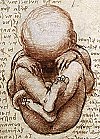
Back Menarche ALS بدء الإحاضة Arabic Менархе Byelorussian Мэнархэ BE-X-OLD Менархе Bulgarian Menarha BS Menarquia Catalan Menarche Czech Menarche German Menarĥo Esperanto
This article has multiple issues. Please help improve it or discuss these issues on the talk page. (Learn how and when to remove these template messages)
|
| Part of a series on |
| Human growth and development |
|---|
 |
| Stages |
| Biological milestones |
| Development and psychology |
Menarche (/məˈnɑːrki/ mə-NAR-kee; from Ancient Greek μήν (mēn) 'month', and ἀρχή (arkhē) 'beginning') is the first menstrual cycle, or first menstrual bleeding, in female humans. From both social and medical perspectives, it is often considered the central event of female puberty, as it signals the possibility of fertility.
Girls experience menarche at different ages.[1][2] Having menarche occur between the ages of 9–14 in the West is considered normal.[3] Canadian psychological researcher Niva Piran claims that menarche or the perceived average age of puberty is used in many cultures to separate girls from activity with boys, and to begin transition into womanhood.[4]
The timing of menarche is influenced by female biology, as well as genetic and environmental factors, especially nutritional factors.[5] The mean age of menarche has declined over the last century, but the magnitude of the decline and the factors responsible remain subjects of contention. The worldwide average age of menarche is very difficult to estimate accurately, and it varies significantly by geographical region, race, ethnicity and other characteristics, and occurs mostly during a span of ages from 8 to 16, with a small percentage of girls having menarche by age 10, and the vast majority having it by the time they were 14.[3] There is a later age of onset in Asian populations compared to the West, but it too is changing with time. For example a Korean study in 2011 showed an overall average age of 12.7, with around 20% before age 12, and more than 90% by age 14.[6] A Chinese study from 2014 published in Acta Paediatrica showed similar results (overall average of age 12.8 in 2005 down to age 12.3 in 2014) and a similar trend in time, but also similar findings about ethnic, cultural, and environmental effects.[7]
The average age of menarche was about 12.7 years in Canada in 2001,[8] and 12.9 in the United Kingdom.[9] A study of girls in Istanbul, Turkey, in 2011 found the median age at menarche to be 12.7 years.[better source needed][10] In the United States, an analysis of 10,590 women aged 15–44 taken from the 2013–2017 round of the CDC's National Survey of Family Growth found a median age of 11.9 years (down from 12.1 in 1995), with a mean of 12.5 years (down from 12.6).[11]
- ^ Thomas, F.; Renaud, F.; Benefice, E.; De Meeüs, T.; Guegan, J. F. (2001). "International variability of ages at menarche and menopause: Patterns and main determinants". Human Biology. 73 (2): 271–290. doi:10.1353/hub.2001.0029. PMID 11446429. S2CID 12330919.
- ^ Cherry, Andrew L.; Dillon, Mary E., eds. (2014). International Handbook of Adolescent Pregnancy. doi:10.1007/978-1-4899-8026-7. ISBN 978-1-4899-8025-0. The statistics are dispersed throughout the chapters specific to different countries around the globe, summarized and cited in several scientific papers.
- ^ a b US National Health Statistics Report, September 2020
- ^ Bobel, C.; Winkler, I. T.; Fahs, B.; Hasson, K. A.; Kissling, E. A.; Roberts, T. A.; Piran, N. (2020). "The Menarche Journey: Embodied Connections and Disconnections". The Palgrave Handbook of Critical Menstruation Studies. pp. 201–214. doi:10.1007/978-981-15-0614-7_18. ISBN 978-981-15-0613-0. PMID 33347201. S2CID 226484326.
- ^ Karapanou O, Papadimitriou A (2010-09-30). "Determinants of menarche". Reproductive Biology and Endocrinology. 8 (1): 115. doi:10.1186/1477-7827-8-115. ISSN 1477-7827. PMC 2958977. PMID 20920296.
- ^ Lee, Mee-Hwa; Kim, Shin Hye; Oh, Minkyung; Lee, Kuk-Wha; Park, Mi-Jung (2016). "Age at menarche in Korean adolescents: Trends and influencing factors". Reproductive Health. 13 (1): 121. doi:10.1186/s12978-016-0240-y. PMC 5035449. PMID 27662834.
- ^ Lei, Yuanting; Luo, Dongmei; Yan, Xiaojin; Zhang, Jingshu; Hu, Peijin; Ma, Jun; Song, Yi; Lau, Patrick W. C. (2021). "The mean age of menarche among Chinese schoolgirls declined by 6 months from 2005 to 2014". Acta Paediatrica. 110 (2): 549–555. doi:10.1111/apa.15441. PMID 32573028. S2CID 219988641.
- ^ Al-Sahab B, Ardern CI, Hamadeh MJ, Tamim H (November 2010). "Age at menarche in Canada: results from the National Longitudinal Survey of Children & Youth". BMC Public Health. 10: 736. doi:10.1186/1471-2458-10-736. PMC 3001737. PMID 21110899.
- ^ Hamilton-Fairley, Diana (2004). Obstetrics and Gynaecology (PDF) (2nd ed.). Blackwell. p. 29. ISBN 978-1-4051-2066-1. Archived from the original (PDF) on 2018-10-09. Retrieved 2013-11-09.
- ^ Atay Z, Turan S, Guran T, Furman A, Bereket A (July 2011). "Puberty and influencing factors in schoolgirls living in Istanbul: end of the secular trend?". Pediatrics. 128 (1): e40–5. doi:10.1542/peds.2010-2267. PMID 21669888. S2CID 24970295.
- ^ https://www.cdc.gov/nchs/data/nhsr/nhsr146-508.pdf [bare URL PDF]
© MMXXIII Rich X Search. We shall prevail. All rights reserved. Rich X Search
